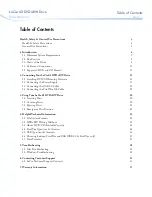
1.3 Features and Advantages of Control Methods
28
YASKAWA
SIEPC71061737B GA800 Drive Technical Reference
*2
Note these points when you use this function:
•
When you can decouple the motor and machine for a test run, use Rotational Auto-Tuning. You must make adjustments to the control
in the range where there is no vibration in the machine after Rotational Auto-Tuning.
•
For vector control, use a 1:1 drive to motor ratio. You cannot use vector control when more than one motor is connected to one drive.
Select a drive capacity so that the motor rated current is 50% to 100% of the drive rated current. If the carrier frequency is too high, the
drive rated current is derated.
•
Motor loss increases during overexcitation braking and high-slip braking. Use a maximum braking frequency of 5% ED and a
maximum braking time of 90 seconds. After you start high-slip braking, you cannot restart the motor until it stops. Use overexcitation
braking to decelerate over a shorter time at a pre-determined speed.
•
Acceleration and deceleration have priority over torque limits in Open Loop Vector Control during acceleration and deceleration (soft
start changes). The drive will not operate until the speed is at the minimum frequency or the reverse direction of motor rotation when
the motor speed decreases because of torque limits during constant speed control. Set
L7-07 = 1 [Torque Limit during Accel/Decel =
Proportional & Integral control]
to enable torque limits during acceleration/deceleration (for winding applications).
Table 1.6 OLV/PM, AOLV/PM, CLV/PM and EZOLV Features and Advantages of Control Methods
Control method
selection
PM Open Loop Vector
Control
(OLV/PM)
PM Advanced Open
Loop Vector
(AOLV/PM)
PM Closed Loop Vector
Control
(CLV/PM)
EZ Open Loop Vector
Control
(EZOLV)
Notes
Controlled
Motor
PM Motor
SynRM (Synchronous
Reluctance Motors)
-
Parameter Setting
A1-02 = 5
A1-02 = 6
A1-02 = 7
A1-02 = 8
-
Basic Control
PM Open Loop Vector
Control (no speed controller)
PM Open Loop Current
Vector Control (with speed
controller)
PM Closed Loop Current
Vector Control (with speed
controller)
Open Loop Current Vector
Control
-
Main Applications
•
General-purpose variable
speed control for PM
motors
•
Applications in which a
high level of
responsiveness and
accurate speed control are
not necessary.
•
General-purpose variable
speed control for IPM
motors
•
Applications in which
high-precision speed
control and torque limits
are necessary.
Very high-performance PM
motor control with motor
encoders
Example: Torque control and
torque limits
Low-speed torque
applications
Example: Fans and pumps
-
PG Option Card
Not necessary
Not necessary
Necessary (PG-X3)
Not necessary
-
Maximum Output
Frequency
590 Hz
400 Hz
400 Hz
120 Hz
-
Speed Control
Range
1:20 AM
1:20 AM
1:100
1:1500
1:100
This is the range of variable control.
When you connect and operate
motors in this mode, think about the
increase in motor temperature.
Starting Torque
100% / 5% speed
100% / 5% speed
200% / 0 min
-1
200% / 0 min
-1
100% / 1% speed
This is the motor torque that the
drive can supply at low speed during
start-up and the related output
frequency (rotation speed).
However, you must think about
drive capacity and motor capacity
when a large quantity of torque is
necessary at low speed.
Auto-Tuning
Stationary, Stator Resistance,
Rotational
Stationary, Stator Resistance,
Rotational
Stationary, Stator Resistance,
Z-phase, Rotational
Line-to-Line Resistance
Automatically tunes electrical motor
parameters.
Torque Limits
No
Yes
Yes
Yes
Controls maximum motor torque to
prevent damage to machines and
loads.
Torque Control
No
Yes
Yes
No
Directly controls motor torque to
control tension and other
parameters.
Droop Control
No
No
Yes
No
Sets load torque slip for motors.
Distributes motor loads.
Zero Servo Control
No
No
Yes
No
Locks servos without an external
position controller to prevent
movement caused by external force.
Speed Search
Yes
Yes
Yes
Yes (Although NOT
operation in the reverse
direction of the Run
command)
Immediately estimates (or detects)
motor speed and direction when
coasting to a stop to quickly start-up
the drive without stopping the
motor.
Automatic Energy-
saving Control
No
Yes (IPM motors only)
Yes (IPM motors only)
Yes
Automatically adjusts the voltage
applied to motors to maximize
motor efficiency for all load sizes.
Summary of Contents for GA800 Series
Page 2: ...This Page Intentionally Blank 2 YASKAWA SIEPC71061737B GA800 Drive Technical Reference...
Page 20: ...i 3 Warranty Information 20 YASKAWA SIEPC71061737B GA800 Drive Technical Reference...
Page 58: ...2 9 Installation Methods 58 YASKAWA SIEPC71061737B GA800 Drive Technical Reference...
Page 268: ...5 6 Safe Disable Input 268 YASKAWA SIEPC71061737B GA800 Drive Technical Reference...
Page 306: ...6 3 MEMOBUS Modbus Communications 306 YASKAWA SIEPC71061737B GA800 Drive Technical Reference...
Page 426: ...8 7 Storage Guidelines 426 YASKAWA SIEPC71061737B GA800 Drive Technical Reference...
















































